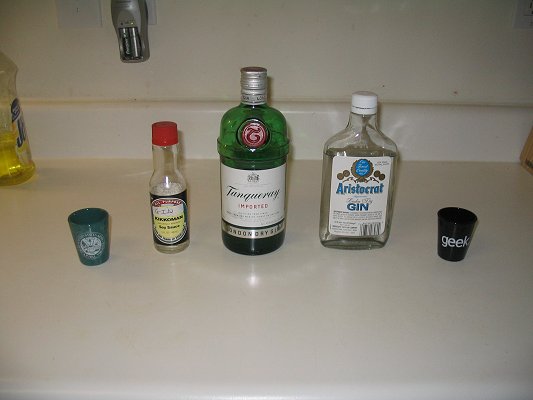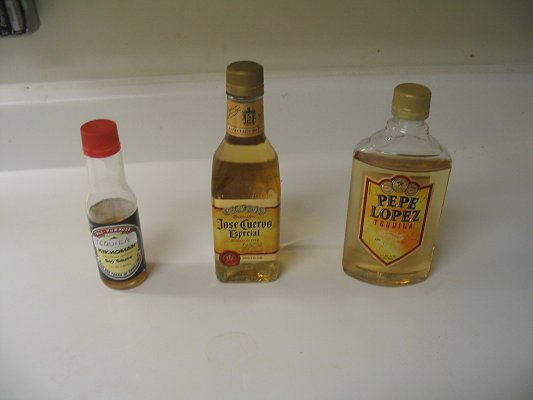The things we do in the name of science (part two)
Welcome back to Infusions of Grandeur for the conclusion of our multi-liquor filtration experiment! Before we head into the results, we'd like to take a moment for an administrative note. (You've been waiting with bated breath anyway, you don't mind, right?)
We are thinking of switching our blog feed to full-article syndication, rather than the short blurb that currently syndicates. However, Ye Olde Feedburner has informed us that over half of our subscribers read us on Ye Olde Live Journal, and we don't want to blow up everyone's friends list unless we're sure about it. So, we'd like to leave it up to you. Let us know which way you would prefer to read our feed; you can leave us a comment here on the blog, over on the LJ feed, or by e-mail at infusions -at- holyducttape.com. Thanks!
Having filtered each of our cheap-ass liquors through a water filter five times, it was now time to bite the bullet. Which is literally what some of them felt like. For each type of liquor, we first tasted the unfiltered cheap stuff that we had set aside, then a medium-grade equivalent, and finally the filtered cheap. We began with the gin. Below, you see the unfiltered sample stored in one of our trademarked ex-soy sauce bottles (because we're classy folks with a reputation to uphold), and the filtered back in its original bottle.

We are both vodka drinkers at our core, so our relative unfamiliarity with other liquors (at least in their straight form) may reduce the complexity of our analysis somewhat. Though we occasionally use rum or whiskey in a mixed drink, gin is a liquor that we seldom use for anything, other than the occasional Long Island Iced Tea. This, despite the fact that as our fellow drink-blogger Jeffrey Morganthaler recently proved, gin is simply infused vodka, something we are intimately familiar with.
We poured two samples of the unfiltered Aristocrat gin and drank.

This gin is rough, to be sure, with a heavy burn going down. I did find the flavor intriguing, though -- no, not good at all, but interesting enough to intrigue me about the real thing. I had tasted straight gin before, but not in many years, probably in my early days of drinking.
"It's basically like a cheap vodka with fruit around the edges," Wayland commented. "It isn't as bad as I thought it might be."
The next gin was Tanqueray, which differs from Aristocrat in more than just production standards: whereas Aristocrat is 80 proof, Tanqueray is 94.6 proof. Though this could be advantageous for some purposes, it made it more difficult to compare the flavor fairly.
"That actually burns worse than the cheap stuff," Wayland wrote. "Of course, the additional 15 proof might have something to do with that. The flavors were similar, but to me, the burn really detracted from the flavor." Personally, I felt that the difference between the two was only faintly apparent.
Finally, the first moment of truth had arrived. We poured samples of the filtered Aristocrat gin and drank them.
Wayland seemed positive about it. "This was much smoother than the first two. I don't think any flavor was lost through the filtration process either."
My reaction was not quite as optimistic. "The harshness is somewhat abated. So is the flavor. It tastes like thinly flavored vodka now."
The light rum came next. We use rum a great deal more than gin, but usually it is either gold or spiced rum. I can't think of a single instance when we've used light rum, other than one weekend filled with Anti-Voyager Zombies, several years ago.
Again, the unfiltered Aristocrat was not as bad as we expected; it was almost smooth, but not quite. The flavor was sweet, but very mild. The burn was relatively light as well. On the whole, it was fairly neutral and unremarkable.
Our mid-grade benchmark was Myers's Platinum White. Though this was meant to be our good rum, I felt a sense of foreboding already from their inability to use proper grammar in their own brand name.
"This wasn't as sweet as the Aristocrat," Wayland noted, "but it was still fairly smooth. It wasn't bad, but I think I actually prefer the cheap stuff."
There was definitely more flavor to this one, in my opinion, but it wasn't a sweet flavor. The label calls it a "rich, buttery flavor;" I wouldn't go that far, but this would be decent in a cocktail.
The filtered Aristocrat, again, was a reduced version of its former self in most factors. The burn was almost completely vanquished, but there was not a great deal of flavor remaining. "It's not as sweet as the unfiltered, but I think it's still sweeter than the Myers's," Wayland noted.
"I could sit and sip this," I said, "but there would be no point in doing so."
Things took a turn for the worse when we tasted the Aristocrat Gold rum. "This is definitely the worst of the rums so far," Wayland commented. "It's sweet, but has a touch of sourness to it as well. The burn is much more than was present in the lighter rums." I described the taste as "mild sweetness, followed by a harsh burn."
As we stated in Monday's introduction to this experiment, we erred in our selection of a mid-grade benchmark by getting a dark, rather than gold, rum. Therefore, the comparison is not really fair, but we're going to make it anyway. "This is pretty much quintessential rum as I think of it," I noted after tasting the Myers's Original Dark. "Strongly flavored and a little sweet, with a burn that's strong, but not too harsh. I wouldn't drink this on the rocks, but it's pretty good, certainly better than the light."
Wayland didn't react as well to the Myers's Dark. "Ugh! Something about that hit my gag reflex. This was the least sweet of the rums we've tasted. Something about the flavor of this just didn't agree with me."
Finally, we sampled the filtered Aristocrat Gold. Remember from our Monday post that this rum had been noticably reduced in color during the filtration process. "I probably liked this the best of the darks," Wayland said, as if that was a compliment. "Although, it seemed the most diluted of the group."
"The loss in flavor is less significant than the loss in burn," I noted, "but that's just because there was so much burn to lose. It still has a little bit of flavor and a little bit of burn, but overall, it seems watered down."
Whiskey was our next stop.

Whiskey gains its deep color from the oak casks in which they are aged. The label states that Aristocrat whiskey is aged for thirty-six months. You would think that after all that, they would take the time to remove the splinters.

This was easily the harshest of the liquors we tasted this night. "Someone call the cops," I said. "We just found a shine runner."
Once our palates had recovered somewhat, we followed up with the old standby, Jack Daniel's. "Much smoother by leaps and bounds, but it is still a bit harsh," I noted. Jack is a favorite of ours for mixed drinks, but it's still not a shooting drink for us. "This was alright," Wayland said. "There was a bit of a taste on the back end that I wasn't overly fond of, but otherwise it's okay."
The filtered Aristocrat whiskey followed the trend set by the previous liquors. "Much smoother still," I said, "but yet again, the filter has removed a lot of the flavor, resulting in another watery-tasting drink."
"This was definitely the best of the whiskeys," Wayland commented. "Of course, it also had the least flavor, so it might just be my own vodka bent."
We could put off the inevitable no longer. It was now time to move on to the tequila, or as we know tonight's cheap brand, "Pepe Motherfucking Lopez."

There is some history between us and Pepe. Seven years ago, a party was held in Wayland's honor. In those days, Wayland's standard drink was the screwdriver, which he tended to pour at quite a heavy mix. At this particular party, one of our "friends" decided he was going to get Wayland wasted, and offered to make him a screwdriver. What Wayland didn't realize at the time is that the screwdriver was spiked with Pepe Lopez.
It was this night that we learned that vodka and tequila do not mix. Wayland didn't get particularly drunk, but he did get sick and spent the rest of the night unconscious, accumulating Reddi-Whip about his person.
Naturally, Wayland would take the first taste of the Pepe tonight.

"That definitely wasn't pleasant, but the taste was mercifully short lived," Wayland said. "I think I can go another seven years before trying it again."
I managed to avoid the tequila that fateful night long ago, but I wouldn't get off so easily this time.

"Damn, that burns. Actually, it's not exactly a burn, it's a gag trigger," I commented once I was capable of doing so. "I know why there's no worm in it. It dissolved without a trace."
Our next sample was Jose Cuervo Especial, which fared somewhat better. "That didn't gag me... quite," I said. "The taste is strange, kind of spicy, but not the kind of spicy I like."
"Jose was definitely smoother than the unfiltered Pepe," said Wayland. "I'm just not a fan of tequila, I think. This is drinkable, just not a first choice."
Lastly, it was time to find out whether the filtration process could do anything to help Pepe along. We poured samples of the filtered tequila and drank.
Wayland noted some improvement. "Of the three tequilas we've tried, this one I might drink again; it was fairly smooth. Not bad, but I'm never going to be much of a tequila drinker, just something about the taste."
I found that the tequila had the very odd property of tasting watered down, yet triggering the gag reflex anyway, though not nearly to the extent of the unfiltered Pepe.
The results of this experiment were disappointing, but not altogether surprising. The filtration trick works so well on vodka due to its simplicity -- it is essentially a mix of water and ethanol. Other liquors, having more complex flavors, contain more compounds that are meant to be there, but can be removed by filtration, reducing it to a seemingly diluted taste. If you are simply looking to make a lot of mixed drinks and get drunk, this may be an option for reducing the harshness of your drinks, and perhaps even the hangover effects (we did not test this theory). However, if you're drinking because you particularly enjoy rum, gin, whiskey or (god help you) tequila, you're better off by far to make the investment and drink decent liquor.

11 comments:
Blast. Oh well. Back to the vodka cupboard.
I'm a gin drinker myself, and I can imagine filtering gin would be like filtering one of your infusions... a loss of flavour. I also find that gins differ in flavour a LOT by brand... Tanqueray and Bombay Sapphire are on par for price, but Bombay is much smoother.
And I read this blog, not your livejournal. If that helps.
I'd prefer seeing this in full on my LJ flist.
Livejournal would be fine as long as you put the majority of the text behind a cut tag. I wouldn't want the full text without a cut tag due to the friends page bloat issue.
But if you're putting in a cut tag, there's not much difference between clicking the link to see the full article and clicking the link to see the blog page as long as the blog site is reliably up, so I guess it would only matter if someone was trying to read your archives on livejournal instead of on the blog page.
Welcome back to the Duo of Drinksmanship!
I second your findings in re buying at least mid-grade liqours if you actually want to taste the liquor.
Love the website! I found it via HOTS link (The Ferrett rocks!)
I read this via blog only.
Continued good wishes! If you want/need a good limoncello receipe, let me know. I made a batch early this year, and just started a second one.
CrazyJohnnyNoname on Myspace
Unfortunately, I don't believe an LJ-cut is possible in a syndicated feed. We could try putting it in the post itself and hope other systems ignore it, but I don't know if it will work properly, though.
I was once warned not to touch cheap tequila, and I'm glad I listened. I actually quite like the more expensive stuff in a cocktail, though.
I've found that Bombay Sapphire infuses a hell of a lot more into their gin than Tanqueray does. It's got a much larger number of ingredients in it. I actually drink it with the small number of vodka infusions that I've made. (Oh yes - except when I mix them with tonic instead.)
Tequila is great! But there is a caveat - that stuff you sampled isn't really tequila, and no amount of filtering is going to fix it - that isn't an impurity issue, it's the ingredients themselves.
Real tequila is likely to set you back $40 a bottle (or more). If you're lucky, you can find small bottles to test them out - I'd recommend Corazon Blanco and Espolon Anejo.
As far as infusion go - I used to make one using blood oranges - you have to cut all the skin off, and all the internal skin that hold the segments together. Then peel the orange part of the outer skin off of the pith (time consuming) and infuse that for a couple of weeks. The cut it with simple syrup (half and half) and age it in a dark place for a few months (6 seemed ideal) - Man! That stuff just got better and better. A great winter cordial.
I've got other findings similar to yours, but for now I'd like to point out that what you said about the "medium grade rum" is true for me.
I LOVE me a Captain Moran + Coke, GREAT drink. I drink Old Grandad or Makers Mark bourbon, neat, all the time.
But I CAN NOT do shots of Captain. They make me GAG.
\/\/
Full posts, please! :D It'll only botch up people's LJ flists for a day.
Welcome back, btw.
Well done guys, as always!
I won't bother filtering any rum now, thanks to this.
Post a Comment